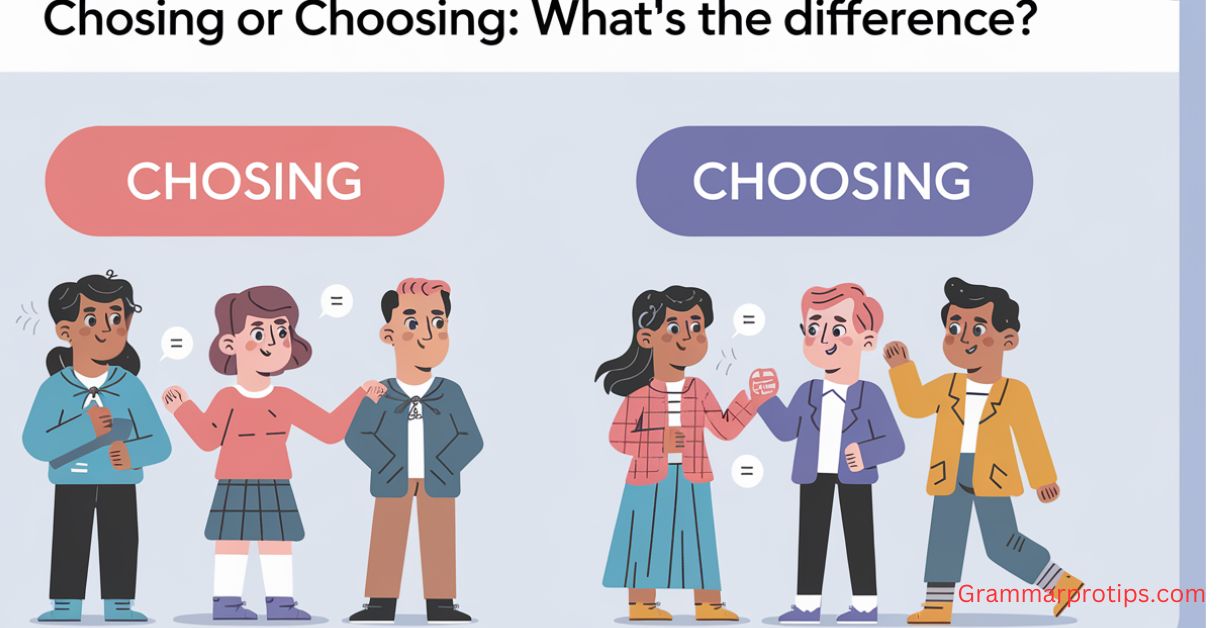Choosing vs Chosing When it comes to mastering the English language, even small details can make a big difference. One such detail is understanding whether to use chosing or choosing. While they may look similar at first glance, there’s actually only one correct spelling and knowing which one to use can save you from unnecessary confusion.
In this article, we’ll explore the nuances of choosing vs chosing, clarify common misconceptions, and provide practical examples to help you avoid mistakes in your writing.
Understanding the Basics of “Choosing”
Before diving into scenarios and explanations, let’s break down what choosing really means. The word choosing is the present participle and gerund form of choose, derived from the verb to choose. It refers to the act of making a decision or selection among options. For instance:
- She is choosing her outfit for the gala tonight.
- They spent hours choosing the perfect venue.
In both cases, choosing emphasizes the ongoing process of decision-making.
Why Is It Choosing and Not Chosing?
The root cause of confusion lies in pronunciation and spelling habits. Many people mistakenly think that because the base verb ends with an “e” (choose), removing the “e” entirely seems logical when adding “-ing.” However, this results in the incorrect spelling chosing.
Instead, the proper rule here involves retaining the silent “e” before adding “-ing,” resulting in choosing. This distinction highlights the importance of recognizing typographical errors like misspellings and ensuring clarity in written communication.
Common Scenarios Where “Choosing” Appears

To better grasp how choosing functions in real-life contexts, let’s examine some everyday situations where it might appear. These examples will also demonstrate why using the correct spelling matters.
Email Example – Selecting Between Options
Imagine you’re drafting an email to your colleague, Sarah, about finalizing plans for a team retreat. Here’s how you might phrase it:
Hi Sarah,
I hope all is well. As we discussed earlier, I’m currently choosing between two potential dates for the retreat. Could you please confirm which works best for everyone on the team?
Thanks,
Alex
Notice how the phrase “choosing between” clearly conveys the action of weighing alternatives. Using chosing instead would introduce a glaring spelling confusion, undermining your professionalism.
Social Media Post – Choosing the Best Option
Now picture yourself crafting a post for Instagram after trying out several recipes over the weekend:
After testing five different cake recipes, I’ve finally settled on my favorite! Choosing the best option wasn’t easy, but this chocolate fudge cake takes the crown. 🎂✨ #BakingAdventures
Here, choosing reflects the thoughtful consideration behind selecting something special. A typo like chosing could distract followers who notice grammatical inconsistencies.
Is It Choosing Among or Choosing Between?

Another frequent question arises when deciding whether to say choosing among or choosing between. Both phrases are valid, but their usage depends on context.
- Use “choosing between” when comparing two distinct items or ideas.
- Example: “I’m choosing between pizza and pasta for dinner.”
- Use “choosing among” when considering three or more possibilities.
- Example: “She’s choosing among five job offers.”
Understanding these distinctions ensures precise word usage while avoiding ambiguity in your sentences.
Clarifying Word Usage – Choosing vs Chosing
Let’s address the elephant in the room: What is the difference between choosing and chosing? Simply put, choosing is the correct spelling, whereas chosing is a common English mistake caused by misunderstanding spelling rules.
How Do You Spell Choosing?
If you ever find yourself wondering, Who do you spell choosing?, remember this simple guideline:
- Keep the silent “e” in choose when forming its gerund/present participle.
- Add “-ing” directly after the “e” to create choosing.
Forgetting this step leads to the incorrect variant chosing, which has no place in standard English vocabulary.
Real-Life Implications of Spelling Errors

Even minor typos can have significant consequences, especially in professional settings. Let’s consider a few hypothetical examples to illustrate this point.
Business Proposal Gone Wrong
Suppose you’re submitting a proposal to secure funding for a startup idea. Your document includes the following sentence:
Our company excels at chosing innovative solutions tailored to client needs.
A sharp-eyed investor might immediately spot the misspelling and question your attention to detail. Such errors can harm credibility and cost opportunities.
Academic Writing Pitfalls
In academic papers, precision is paramount. Imagine writing a thesis statement like this:
This study focuses on chosing effective strategies for improving student engagement.
An advisor or peer reviewer would likely flag this as a typo correction issue, detracting from the overall quality of your work.
Tips for Avoiding Mistakes in Writing
To prevent falling into the trap of spelling confusion, follow these practical tips:
- Double-check homophones: Words that sound alike (e.g., choosing vs. chosing) often lead to mix-ups.
- Use grammar tools: Platforms like Grammarly or Hemingway Editor can catch typographical errors automatically.
- Practice consistently: Regular exposure to correctly spelled words reinforces good habits.
- Review examples: Reading high-quality texts helps internalize proper usage patterns.
By incorporating these strategies, you’ll minimize the risk of committing common English mistakes.
Choosing Alternatives and Synonyms
While choosing remains the most versatile term for expressing decision-making, synonyms can add variety to your writing. Consider these alternatives:
- Selecting
- Picking
- Opting for
- Deciding on
- Electing
Each synonym carries slightly different connotations, so choose wisely based on tone and context.
Table Comparing Correct and Incorrect Forms
Below is a quick reference table summarizing key points about choosing and chosing:
| Term | Definition | Correct Spelling | Notes |
|---|---|---|---|
| Choosing | Present participle of choose | Correct | Retains silent “e”; used widely in English |
| Chosing | Misspelled version of choosing | Incorrect | Common error; lacks validity |
This table serves as a handy guide for anyone seeking clarity on proper English usage.
Conclusion – Mastering the Art of Choosing
In conclusion, understanding the difference between chosing or choosing boils down to grasping basic spelling principles. By remembering to retain the silent “e” in choose and applying it correctly, you can confidently navigate decision-making scenarios without hesitation.
Whether you’re drafting emails, composing social media posts, or preparing formal documents, prioritizing accuracy ensures your message resonates effectively. Remember, error correction isn’t just about fixing typos—it’s about presenting yourself as knowledgeable and trustworthy.
So next time someone asks, Is it choosing or chosing?, you’ll know exactly how to respond. Happy writing!
With this comprehensive guide, you now possess the tools to tackle choosing-related challenges head-on. Embrace the power of precise language, and watch your communication skills soar!

“Smith is the dedicated admin of [grammarprotips.com], a platform focused on enhancing grammar skills. With a passion for language and education, Smith strives to make grammar accessible and enjoyable for learners of all levels. Committed to delivering high-quality content, Smith continually explores innovative ways to help users master the complexities of grammar.”

